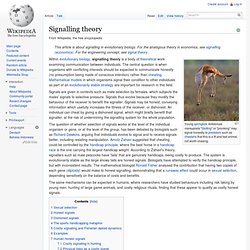

Quorum sensing gene regulation.3. Emergence. In philosophy, systems theory, science, and art, emergence is a process whereby larger entities, patterns, and regularities arise through interactions among smaller or simpler entities that themselves do not exhibit such properties.

Emergence is central in theories of integrative levels and of complex systems. For instance, the phenomenon life as studied in biology is commonly perceived as an emergent property of interacting molecules as studied in chemistry, whose phenomena reflect interactions among elementary particles, modeled in particle physics, that at such higher mass—via substantial conglomeration—exhibit motion as modeled in gravitational physics. Neurobiological phenomena are often presumed to suffice as the underlying basis of psychological phenomena, whereby economic phenomena are in turn presumed to principally emerge. Semiotics. Semiotics frequently is seen as having important anthropological dimensions; for example, Umberto Eco proposes that every cultural phenomenon may be studied as communication.[2] Some semioticians focus on the logical dimensions of the science, however.

They examine areas belonging also to the life sciences – such as how organisms make predictions about, and adapt to, their semiotic niche in the world (see semiosis). In general, semiotic theories take signs or sign systems as their object of study: the communication of information in living organisms is covered in biosemiotics (including zoosemiotics). Syntactics is the branch of semiotics that deals with the formal properties of signs and symbols.[3] More precisely, syntactics deals with the "rules that govern how words are combined to form phrases and sentences".[4] Terminology[edit] Ferdinand de Saussure, however, founded his semiotics, which he called semiology, in the social sciences: History[edit] Formulations[edit] Branches[edit] Notes. Signalling theory. Signals are given in contexts such as mate selection by females, which subjects the males' signals to selective pressure.

Signals thus evolve because they modify the behaviour of the receiver to benefit the signaller. Signals may be honest, conveying information which usefully increases the fitness of the receiver, or dishonest. An individual can cheat by giving a dishonest signal, which might briefly benefit that signaller, at the risk of undermining the signalling system for the whole population.
The question of whether selection of signals works at the level of the individual organism or gene, or at the level of the group, has been debated by biologists such as Richard Dawkins, arguing that individuals evolve to signal and to receive signals better, including resisting manipulation. Amotz Zahavi suggested that cheating could be controlled by the handicap principle, where the best horse in a handicap race is the one carrying the largest handicap weight. Sexual selection[edit] Notch signaling pathway. Structure of the ligand binding region of the human NOTCH-1 receptor Notch-mediated juxtacrine signal between adjacent cells.

Discovery[edit] In 1914, John S. Dexter noticed the appearance of a notch in the wings of the fruit fly Drosophila melanogaster. The alleles of the gene were identified in 1917 by Thomas Hunt Morgan.[3][4] Its molecular analysis and sequencing was independently undertaken in the 1980s by Spyros Artavanis-Tsakonas and Michael W. Mechanism of action[edit] The cleavage model was first proposed in 1993 based on work done with Drosophila Notch and C. elegans lin-12,[12][13] informed by the first oncogenic mutation affecting a human Notch gene.[14] Compelling evidence for this model was provided in 1998 by in vivo analysis in Drosophila by Gary Struhl[15] and in cell culture by Raphael Kopan.[16] Although this model was initially disputed,[1] the evidence in favor of the model was irrefutable by 2001.[17][18] Function[edit]
Feedback. "...'feedback' exists between two parts when each affects the other.

"[1](p53, §4/11) A feedback loop where all outputs of a process are available as causal inputs to that process "Simple causal reasoning about a feedback system is difficult because the first system influences the second and second system influences the first, leading to a circular argument. In this context, the term "feedback" has also been used as an abbreviation for: Jamming avoidance response. Two neighboring Eigenmannia perform the jamming avoidance response: When one fish with an electric discharge of 400 Hz encounters a second fish with the same frequency, one fish shifts its frequency upward and the other shifts its frequency downward.

The jamming avoidance response or JAR is a behavior performed by some species of weakly electric fish. The JAR occurs when two electric fish with wave discharges meet – if their discharge frequencies are very similar, each fish will shift its discharge frequency to increase the difference between the two fish's discharge frequencies. By doing this, both fish prevent jamming of their sense of electroreception. The behavior has been most intensively studied in the South American species Eigenmannia virescens (order Gymnotiformes). The behavior is also present in other Gymnotiformes such as Apteronotus, as well as in the African species Gymnarchus niloticus (order Osteoglossiformes).